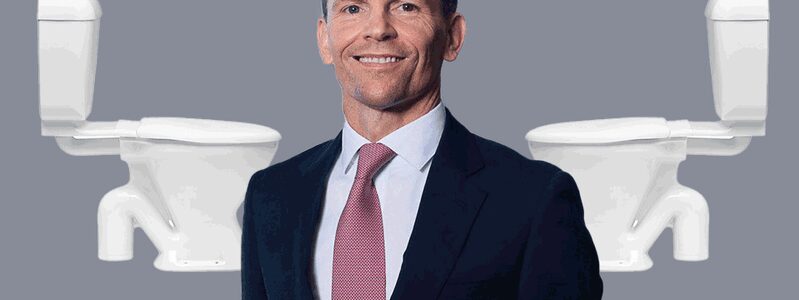
Can bathroom behemoth Reece survive the construction squeeze?
More than a century after the company’s eponymous founder sold his first plumbing products from the back of a truck, Reece has become a part of the furniture in homes across Australia.
The $11.4 billion company’s products, from ventilation to waterworks, ensure that the air is flowing, and toilets are flushing – not just Down Under, but around the world.
Reece chief executive Peter Wilson. The Wilson family still owns about 35 per cent of the company, plus more through various investment vehicles. Credit:Christopher Pearce
The Wilson family has in effect controlled and steered the company since the moon landing in 1969, and has taken it to stratospheric heights over the past 50 years. Now, the business makes billions of dollars in sales every year.
While Reece has become a household name that has weathered recessions and most recently a global pandemic, a slowdown in markets – particularly new construction in the US and a contraction in consumers looking to renovate – weighs on the company’s outlook.
As the water starts to rise, can Reece keep the oxygen flowing?
Industry: Construction supplies and fixtures.
Main products: Plumbing, bathroom, heating, ventilation, air-conditioning, waterworks and refrigeration products.
Key figures: Chief executive Peter Wilson, acting chair Timothy Poole and executive director Alan Wilson.
How it started: Back in 1919, Harold Joseph Reece started selling plumbing products from the back of his truck. He later opened the first HJ Reece store in the Melbourne suburb of Caulfield and in 1958, Les Wilson took a seat on the board and began buying shares in the company.
By 1969, the Wilson family were the majority shareholders of the company. Wilson’s son, Alan, who started Austral Hardware, later became chief executive of Reece and consolidated the two companies. Reece listed on the ASX on New Year’s Day, 1974.
How it’s going: The humble one-man truck-based operation from the 1920s has built up to become the country’s largest plumbing and bathroom supplies business employing more than 9000 people. In 2006, Reece went international, opening its first overseas store in New Zealand. Since then, it has expanded to more than 800 branches across the two countries, as well as the United States.
While the company is best known for its plumbing products, it has also expanded to provide inputs for industries such as commercial heating, ventilation and air conditioning, as well as fire solutions. Reece supplies these various products to both commercial and residential customers and raked in $4.4 billion in sales revenue in the six months to December.
Reece’s share price has been on a rollercoaster for the past two years, surging from about $8.13 a share in May 2020, to a peak of $27.33 a share on January 7, 2022, and trading at $17.65 a share as of Tuesday.
The bull case: Despite skyrocketing inflation, the company’s most recent figures show it has managed costs well and achieved an operationally strong result – including an edge up in its gross profits.
Wilson Asset Management senior equity analyst Sam Koch said the US market, where Reece has over 200 stores, presented a substantial opportunity for the company to grow.
“Their US business is a lot more resilient than the market gives them credit for,” Koch said. “Their geographic exposure to the Sunbelt region, which has benefitted from interstate migration, has proven to be relatively more resilient than the rest of the market.”
While Koch expects housing volumes to trough in the next nine to 12 months, he said Reece could take advantage of the slowdown by increasing their rollout, taking market share from competitors and entrenching their business model in the US.
Koch also said the renovation activity would likely hold up. “If people aren’t buying a new house because they’re worried about mortgage rates, then they’re probably going to put a bit more money into refreshing their own home.”
Finally, Koch said Reece could continue to take advantage of the inflationary environment, even as price pressures look to ease. “The company has weathered input cost pressures incredibly well by passing them onto customers,” he said.
We believe they’ll be able to hold on to more than their fair share of margin even as input cost pressures ease.”
The bear case: While Reece has a solid track record of navigating tough conditions, Macquarie analysts wrote in a research report in February that they expected choppy waters ahead in both Australia and the US.
“We think conditions in Australia could get meaningfully tougher over the next 12 months,” they said. Although Reece didn’t offer specific guidance on their sales for the near future, the Macquarie analysts pointed to slowing volumes in the three months to December of 2 per cent in Australia and 6 per cent in the US.
“In the US, the sharp fall in new construction activity weighed on volumes,” they said, noting the roughly 40 per cent exposure the company has to new construction markets as a risk amid the downturn in building activity.
Morgan Stanley equity analyst Andrew G Scott pointed to further downside risks including supply constraints increasing Reece’s costs and a decline in demand denting the company’s earnings. Scott wrote in a research report that the recent burst in renovation activity – one of the company’s drivers of sales – “could dissolve when economies begin to reopen and activities such as travel resume”.
- Advice given in this article is general in nature and is not intended to influence readers’ decisions about investing or financial products. They should always seek their own professional advice that takes into account their own personal circumstances before making any financial decisions.
Most Viewed in Money
From our partners
Source: Read Full Article
